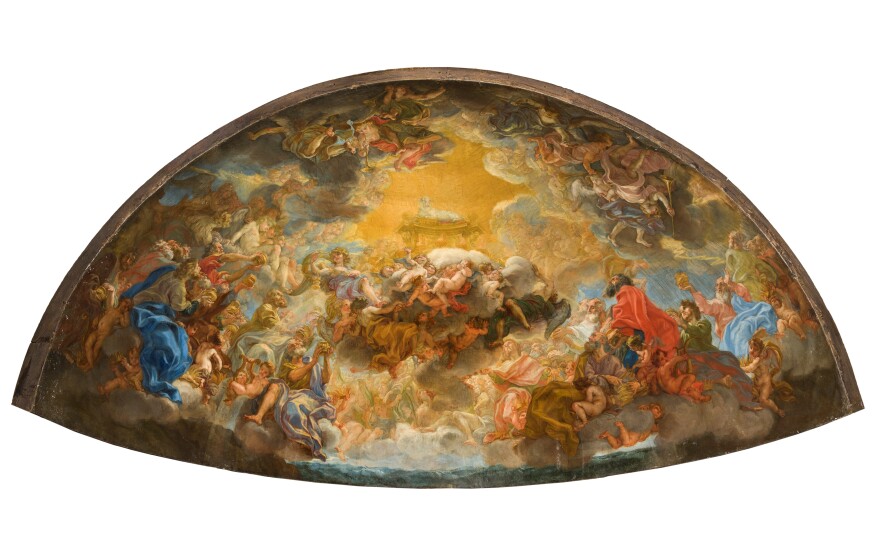Nearly 400 years ago, a young Gian Lorenzo Bernini was commissioned by a powerful Cardinal’s family to decorate the first Jesuit church in Rome. Now, Bernini's work—a bust of Cardinal Roberto Bellarmino—has left Rome for the first time for an exhibition at Fairfield University Art Museum in Connecticut.
When you step inside the exhibit—THE HOLY NAME Art of the Gesù: Bernini and his Age—it’s like stepping behind the scenes of the creation of one of the most important monuments in Baroque Rome: the Church of the Gesù.
Linda Wolk-Simon, museum director and chief curator, says, “There are five works from the Gesù [and] none of those have come to America.”

Wolk-Simon points out pieces collected from the church and private galleries around the world, like the gold embroidered ecclesiastical vestment that priests would wear for special Mass.
There’s even a model of the fresco that the great Giovanni Gaulli painted on the church ceiling...and of course, the Bernini portrait bust.

It’s a nearly life-size sculpture of Fairfield University’s patron saint, Cardinal Roberto Bellarmino, from the waist up. Soft white light casts over Bellarmino as he stretches his white marble hands out in prayer.

“It’s the highlight of the exhibition and I don't mean at all to diminish the other works because to me there are many, many highlights, but it’s the highlight of the highlights.”
Wolk-Simon says most of Bernini’s architectural works at St. Peter’s Basilica are not meant to be moved. But this two-foot tall bust is a portable example of the style Bernini would eventually trademark.
“It’s of exceptional, unparalleled, extraordinary importance, both because Bernini is one of the giants of Western art, one of the greatest sculptors of all times, and this work in particular has never been seen.”
That’s because the bust normally rests up in the apse of the Gesù. But here, Wolk-Simon takes a step closer to look eye to eye with Bellarmino.
“You can see the stubble of his face. Now why did Bernini do that? This figure was just always up very high, no one would have seen that, but it just like, you know, to him marble was just like the way anyone else would have modeled in clay.”
So how did a rare early Bernini sculpture leave Rome for the first time to come all the way to Connecticut? Wolk-Simon says it began with a colleague’s crazy idea.
The colleague is Xavier Salomon, the Peter J. Sharp curator at the Frick Collection in New York.
Salomon joined Linda Wolk-Simon’s committee a few years ago. There, he dreamt up a scenario: if they could lone just one piece from the Church of the Gesù, what would it be?
“The idea was thrown out there as almost an impossible idea. I mean when we first had this conversation with Linda we thought, ‘Oh, that would be great but how can we do this?’” Salomon said.
So Wolk-Simon enlisted her university connections and the help of the top Jesuit scholar living today. They sent a letter to THE leader of the Jesuits in Rome who could convince Italian officials to let the Bernini leave the country.
And Father General Arturo Sosa gave her a response: “I was happy to help. This bust is not simply an outstanding work of art by an extraordinary sculptor. It also reminds Fairfield of its Jesuit identity and mission.”
The Superior General says the piece is a special way to commemorate the University’s Jesuit history. Xavier remembers meeting Jesuit leaders in Italy to prepare for the Bernini’s big move.

“Linda and I went to Rome and met with the rector of the church of the Gesù and people from the…and we climbed up a sort of rickety ladder to get to the top of this niche and get to see the bust close up and it was the first time that either of us, or many other people, have seen it that closely.”
Salomon says the chance to see the bust up close and alongside the other masterworks should not be missed.
“I’m an expert in this field and I've known most of these objects so far…you will never get this again.”
The last day to see the Art of the Gesù is this Saturday, May 19.

